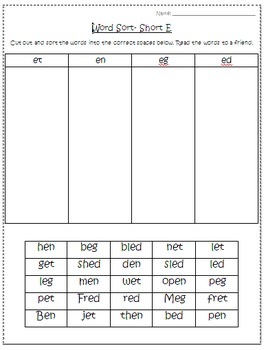Word SortDefinition
A Word Sort is a simple individual or small group activity. Students list key words from a reading selection. (Alternatively, the teacher may provide a list of terms prior to the reading activity.) Students identify the meaning and properties of each word and then "sort" the list into collections of words with similar features. This "sorting" process links students' prior knowledge to the basic vocabulary of a reading selection (Reading Educator, 2015). There are two common forms of Word Sorts:
|
Lesson Plan Examples
Resources:
Bell, M. (2012). ReadStrong - Word Sorts. Retrieved October 2, 2015, from http://myweb.stedwards.edu/mikekb/ReadStrong/wordsorts.html
Concept Sort. (2015). Retrieved October 1, 2015, from http://www.readingrockets.org/strategies/concept_sort
Common Core State Standards: Small Group Word Sort. (2013, September 13). Retrieved October 1, 2015, from https://www.youtube.com/watch?v=sjgUx7zSX14
Reading Educator. (2015). Retrieved October 1, 2015, from http://www.readingeducator.com/strategies/sort.htm
Riebe, E. (2013, October 30). Word Sorts What Do We Do. Retrieved October 1, 2015, from https://www.youtube.com/watch?v=UAoHriJ6_1Y
Word Study in Action- Word Sorting. (2009). Retrieved October 1, 2015, from http://mypearsontraining.com/pdfs/TG_WTW_WordSorting.pdf?checked=1437332499
Bell, M. (2012). ReadStrong - Word Sorts. Retrieved October 2, 2015, from http://myweb.stedwards.edu/mikekb/ReadStrong/wordsorts.html
Concept Sort. (2015). Retrieved October 1, 2015, from http://www.readingrockets.org/strategies/concept_sort
Common Core State Standards: Small Group Word Sort. (2013, September 13). Retrieved October 1, 2015, from https://www.youtube.com/watch?v=sjgUx7zSX14
Reading Educator. (2015). Retrieved October 1, 2015, from http://www.readingeducator.com/strategies/sort.htm
Riebe, E. (2013, October 30). Word Sorts What Do We Do. Retrieved October 1, 2015, from https://www.youtube.com/watch?v=UAoHriJ6_1Y
Word Study in Action- Word Sorting. (2009). Retrieved October 1, 2015, from http://mypearsontraining.com/pdfs/TG_WTW_WordSorting.pdf?checked=1437332499

